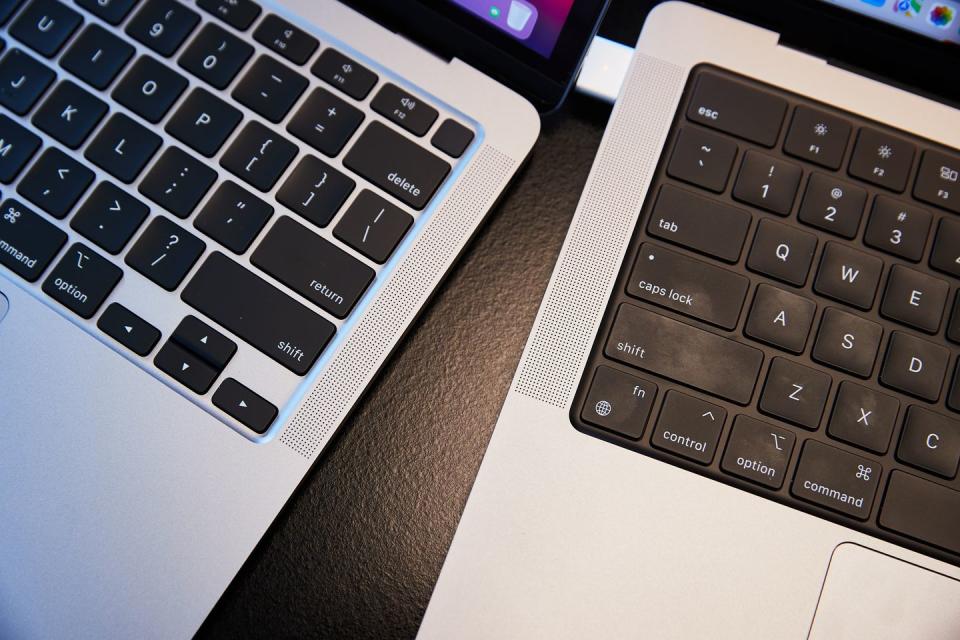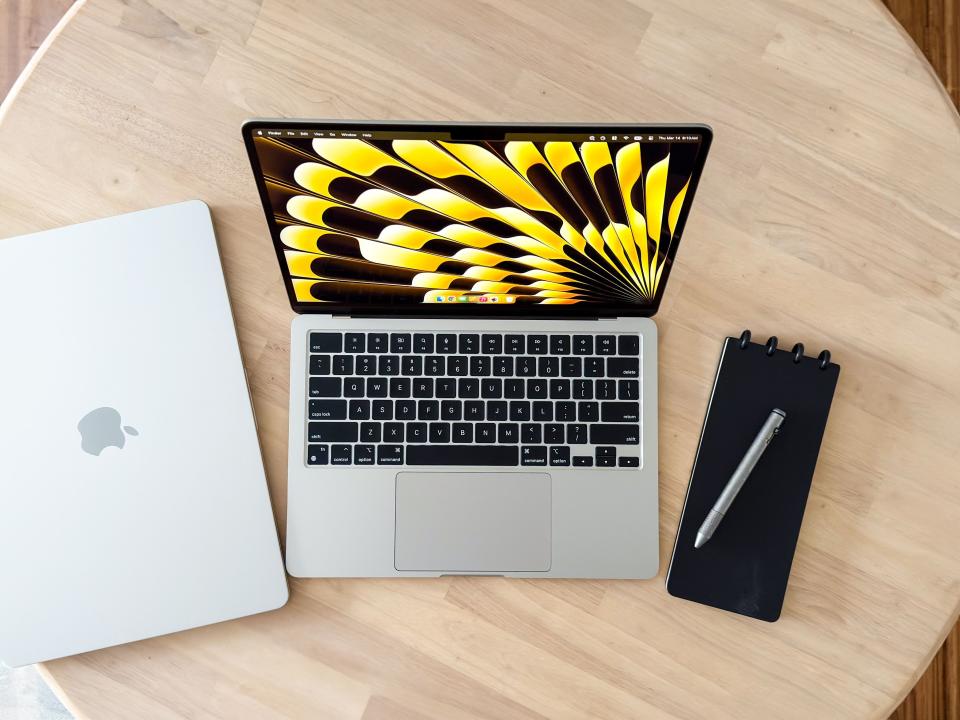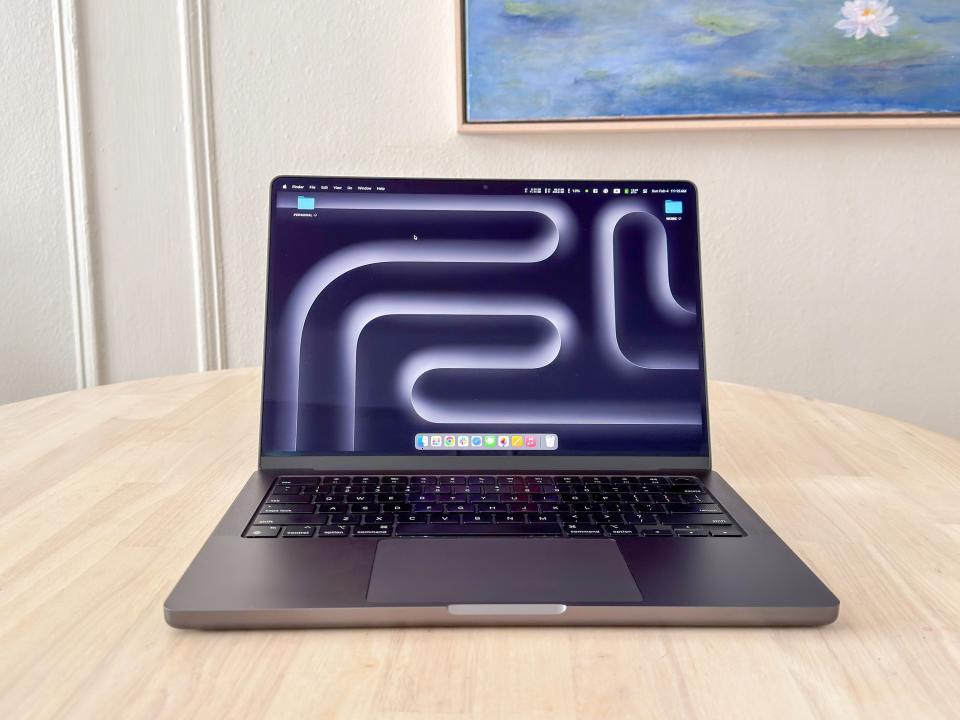“Hearst Magazines and Yahoo may earn commission or revenue on some items through these links.”
If you’re looking to buy a new laptop for yourself or as a very generous gift, look no further than the MacBook. From the entry-level Air all the way to the range-topping Pro, all of Apple’s notebooks today have an elegant design, exceptional craftsmanship, powerful hardware with uncompromising performance, and outstanding battery life.
Every new MacBook rocks an Apple chip developed in-house, whose all-around performance and energy efficiency are miles ahead of the components found in their PC and Chromebook rivals. The playing field began charging dramatically in Apple’s favor with the introduction of the M1 chip in 2020.
MacBooks have always been stellar products, and they keep getting better. After kicking off 2023 by refreshing the range-topping 14- and 16-inch MacBook Pros with even more powerful M2 Pro and M2 Max chips, Apple finished the year by treating its top-shelf Pro notebooks to even more capable M3, M3 Pro, and M3 Max silicon. The big-screen Pros were joined in March 2024 by a refreshed MacBook Air with the Apple M3 chip on board.

Of course, Apple’s portable computers pack a top-tier display, an awesome Magic Keyboard with a Touch ID fingerprint sensor, and a precise trackpad with Force Touch. Powered by macOS, every MacBook offers an intuitive and secure platform with an abundant selection of apps and many years’ worth of free updates that will bring cool new features. Every MacBook is also backed by an amazing selection of accessories.
But how do you know which MacBook is best for your needs? We spent weeks testing every member of the MacBook lineup so we can help you choose the right one for yourself or to treat someone to a gift they’ll never forget — from the budget-friendly Air to the unstoppable Pro with an M3 Max chip.
The Best MacBooks
How We Tested
I have spent weeks using every MacBook on this list as my primary computer for work and everything else. My typical workflow consists of using a web browser with 10-15 open tabs, editing images in Pixelmator Pro, creating content in Apple Pages and Google Docs, and fielding a constant stream of emails and Slack messages, all while streaming my go-to playlists from Apple Music. I used every notebook on battery power to evaluate whether or not its real-life endurance measures up to its maker’s claims.
When I wasn’t working, I used every MacBook to browse the web and social media, keep in touch with family and friends via iMessage and Facetime, and play video games from the collection of titles available in the App Store. (I used external gaming controllers during these activities.)
Learn more about the best MacBooks available today and find the best one for your needs or gift someone an upgrade they’ll never forget among the options below.
Best Overall

MacBook Air with M3 chip (13.6-inch)
amazon.com
$899.00
Stefan Vazharov
The latest MacBook Air with the Apple M3 chip is the best laptop for the money and a fantastic option for most consumers. It has a beautiful design with a silhouette similar to the range-topping MacBook Pros, top-tier specs, excellent performance, and outstanding battery life. Because it lacks built-in cooling fans, the notebook is impossibly slim without sacrificing performance.
Starting just a tad north of $1,000 before additional deals and discounts, the computer is also an incredible value, given its power, speed, and battery life. Like its predecessor, the new MacBook Air is available with a 13- or 15-inch display. I prefer the big-screen version because it offers better overall performance and value than any rival while remaining super portable.
Compared to the MacBook Air with the Apple M1 chip, the M3 iteration brings a significant power bump across the board — up to 60%, to be precise — while offering up to 18 hours of battery life. The newcomer also packs a bigger, brighter, and sharper Retina display, a higher-resolution FaceTime camera, a MagSafe charging connector, and a more sophisticated speaker setup with spatial audio support.
Impressively, the M3 chip has made the new MacBook Air a surprisingly capable gaming rig. While evaluating the notebook, I enjoyed playing blockbuster titles like Death Stranding and Resident Evil 4 in complete silence.
Apple offers the new MacBook Air in midnight, starlight, silver, and space gray finishes. Each color option comes with a matching woven MagSafe cable. Apple’s previous MacBook Air with the M2 chip is still a fantastic option, courtesy of its sub-$1,000 sticker. The M1-toting MacBook Air with the iconic wedge design is available for even less if you’re shopping on a tighter budget.
Best Compact

MacBook Pro with M3 Chip
amazon.com
$1399.99
Stefan Vazharov
Fresh off an update to the Apple M3 chips, the 14-inch MacBook Pro with a 13-inch Retina display is the one to get if you need a small laptop for heavy workloads, like sifting through a double-digit amount of open apps, editing high-resolution videos, compiling code, and even high-performance gaming. I’ve been using it for work and to game on the weekends since its debut, and it’s been excellent. Regardless of its price tag, no PC rival can produce the same concoction of power, portability, and battery life.
A follow-up to the 13-inch MacBook Pro with the M2 chip and a Touch Bar, the 14-inch iteration has superior hardware and performance even in entry-level guise. Thanks to a more powerful chip with an onboard cooling system and a brighter screen with ProMotion tech, the starter 14-inch MacBook Pro would be my choice over any similarly priced MacBook Air, despite being marginally thicker and heavier. Computer chips usually throttle their power upon warming up, hence the importance of onboard fans.
Impressively, you can equip the 14-inch MacBook Pro with any of the latest Apple M3 chips. The most affordable version with the M3 is great for most consumers, while the M3 Pro-equipped variant will suit more demanding users who need a portable powerhouse. The M3 Max-equipped MacBook Pro is for those who need a take-anywhere computer with more power than most desktop workstations.
The 14-inch MacBook Pro with the M3 chip is available in silver or space gray with up to 24 GB of RAM. I’m not a fan of the lowest-priced model having only 8 GB, so I recommend you spend a bit more to upgrade it. The M3 Pro and M3 Max versions are available in silver and space black, with up to a head-spinning 128 GB of RAM. I tip my hat to the tech giant for equipping the M3 Pro and Max versions with at least 18 GB of RAM.
Best Big-Screen

MacBook Pro
amazon.com
$1999.00
Stefan Vazharov
The big-screen 16-inch MacBook Pro — Apple’s most capable and versatile laptop to date — is the best for power users looking for desktop-worthy power and long battery life. Weighing less than 5 pounds, the sleek laptop is also incredibly portable, given its specs and everyday performance. It’s a great sequel to the previous version with the M2 Pro and M2 Max chip.
Compared to the 14-inch version, the 16-inch MacBook Pro has a bigger screen that’s even more suitable for multitasking. I had no trouble comfortably running two apps side by side while using the big-screen notebook. The larger screen also treated me to great visuals while streaming video and gaming.
The bigger laptop’s 22-hour maximum battery life is also longer, setting a gold standard for the entire product category. Being able to get more screen time between charges makes the 16-inch version worth its extra weight and higher price over a similarly equipped 14-inch MacBook Pro. I’d pick this notebook over any rival for this feature alone before factoring in everything else it has to offer.
Depending on your needs (and budget), you can order the product in silver or space black with the Apple M3 Pro or M3 Max chips.
What to Consider
Chip
Regardless of your budget and choice, you’ll get a laptop with more graphics, processing power, and everyday speed than any similarly priced alternative without an Apple logo. All Apple chips utilize an advanced 3- or 5-nanometer architecture, which allows them to pack billions of transistors into a minuscule bit.
Apple is the first computer manufacturer to utilize the above tech, giving its MacBooks the ability to provide a fine equilibrium between power and energy efficiency. In real life, this translates into easily getting a workday’s worth of screen-on time without having to look for a power outlet or a battery pack. For comparison, a high-end Intel laptop chip utilizes a 7-nanometer architecture, so it can’t offer the same combination of high power and low energy consumption.
The entry-level MacBook Air and Pro versions are everything someone could need for everyday use, school projects, and work. These are the laptops that most upgraders looking for a good all-around notebook should consider. They are also foolproof gift options for students or anyone else in need of a new MacBook.
If you need more power to breeze through demanding tasks such as editing high-resolution photos and video, you should consider the 14- or 16-inch MacBook Pro with an M3 Pro and M3 Max chip. The last-mentioned bits give them higher memory bandwidth and more GPU cores than their M1 and M2 siblings, translating into better and faster performance during demanding tasks like video editing, coding, and gaming, among others.
Apple’s M3 chips are the company’s first to support enhanced graphics with ray tracing. Brought by an upgraded GPU, that functionality results in immersive app and game visuals. The powerful graphics make the latest MacBooks excellent portable gaming rigs, capable of delivering a growing list of AAA titles like Lies of Pi, Resident Evil 4, and Death Stranding, to name a few Blockbuster ones, with the quality they deserve. And macOS offers exceptional support for original Xbox and PlayStation controllers, making console-grade gameplay easily achievable.
Display
Every MacBook has a sharp Retina display with True Tone technology, ensuring consistently accurate color reproduction in any lighting. There are three screen size options: 13-, 14-, or 16-inch.
Choosing the most portable option will help you decide whether a MacBook Air or a MacBook Pro is best for you. In my experience, 13-inch MacBooks are best for portability (e.g., in a coffee shop, a classroom, etc.). The 14-inch MacBook Pro offers a nice balance between hardware oomph and portability, while the noticeably bulkier 16-inch version can deliver a desktop-grade experience anywhere you take it.
It is important to note that the 14- and 16-inch MacBook Pro models have superior Liquid Retina XDR displays with mini-LED backlighting and higher peak brightness. These screens show their worth in scenarios with bright ambient lighting (e.g., using the notebook outdoors or close to an indoor light source) by producing clear and vibrant visuals. Additionally, these vibrant displays offer ProMotion tech with a higher refresh rate for more fluid interactions and gameplay.
Other Hardware Bits
Additional specs such as memory and storage capacity and connectivity options (wired and wireless ) are also important to consider. Unlike many PC laptops, MacBooks are not upgradeable. Trying to tinker with them could result in a void warranty, so you’ll have to ensure your pick can meet your needs long after purchasing it. Spending more will get you more graphics and processing power, more RAM for next-level multitasking, and more storage.
I recommend that you order a variant with ample RAM and storage. Thankfully, unless you are a heavy multitasker, you will find the 8GB of onboard RAM and 256GB of storage in the entry-level MacBook Air and Pro versions plenty sufficient.
When it comes to wireless connectivity, you should know that fast Wi-Fi 6 and Wi-Fi 6E are available on all new MacBooks. Every MacBook iteration has a pair or a quartet of Thunderbolt-compatible USB-C ports, as well as futureproof Bluetooth 5.0 (and higher) connectivity. The last-mentioned feature guarantees a stable connection with the latest wireless earbuds, headphones, and speakers.
You Might Also Like
Source Agencies


